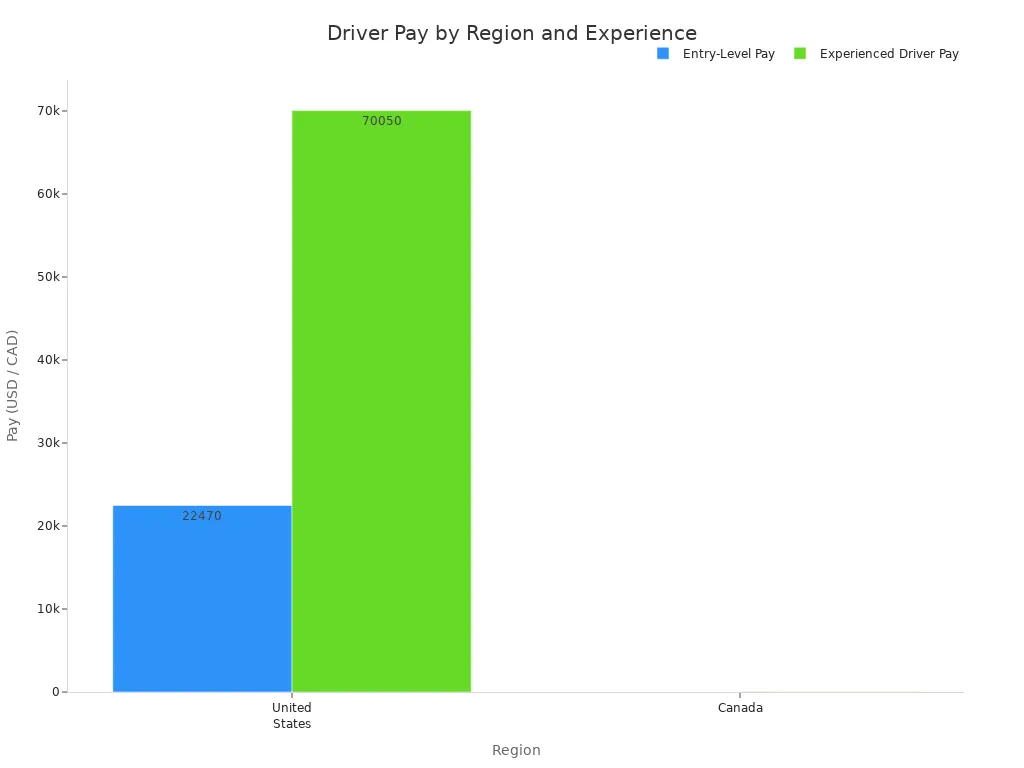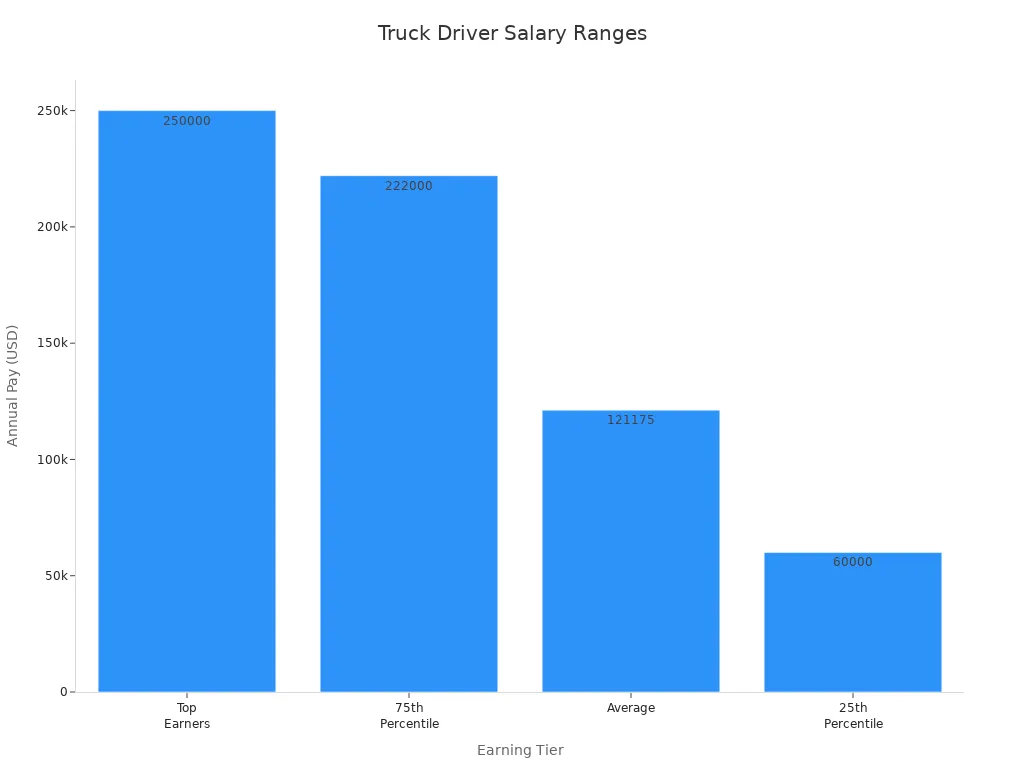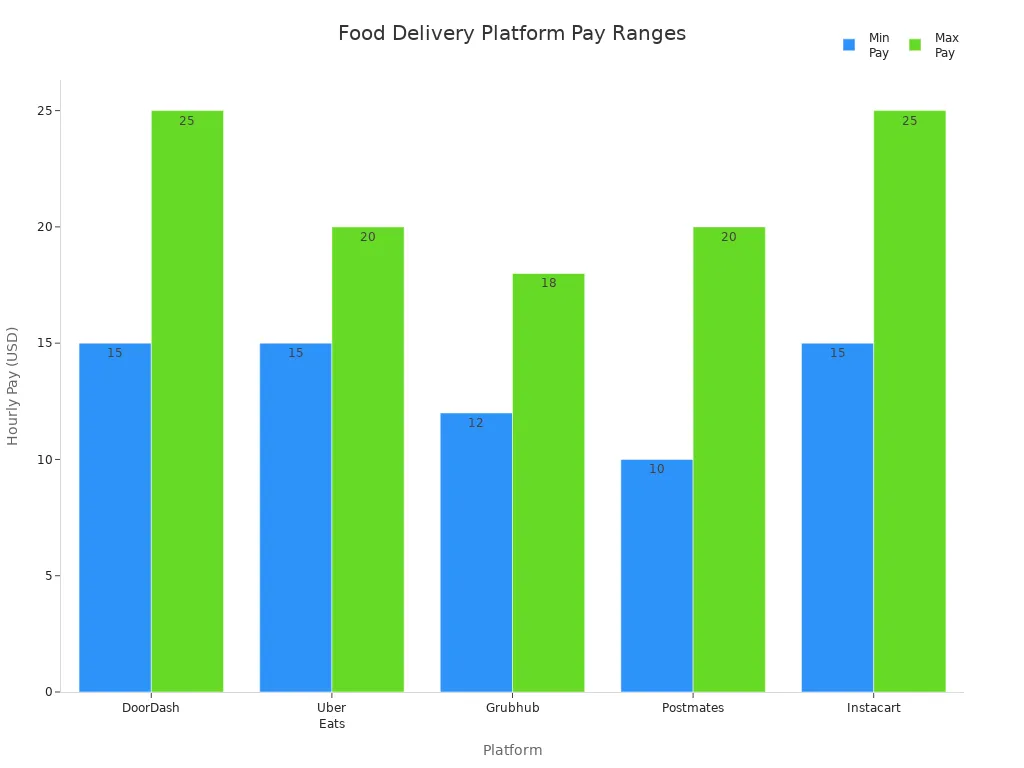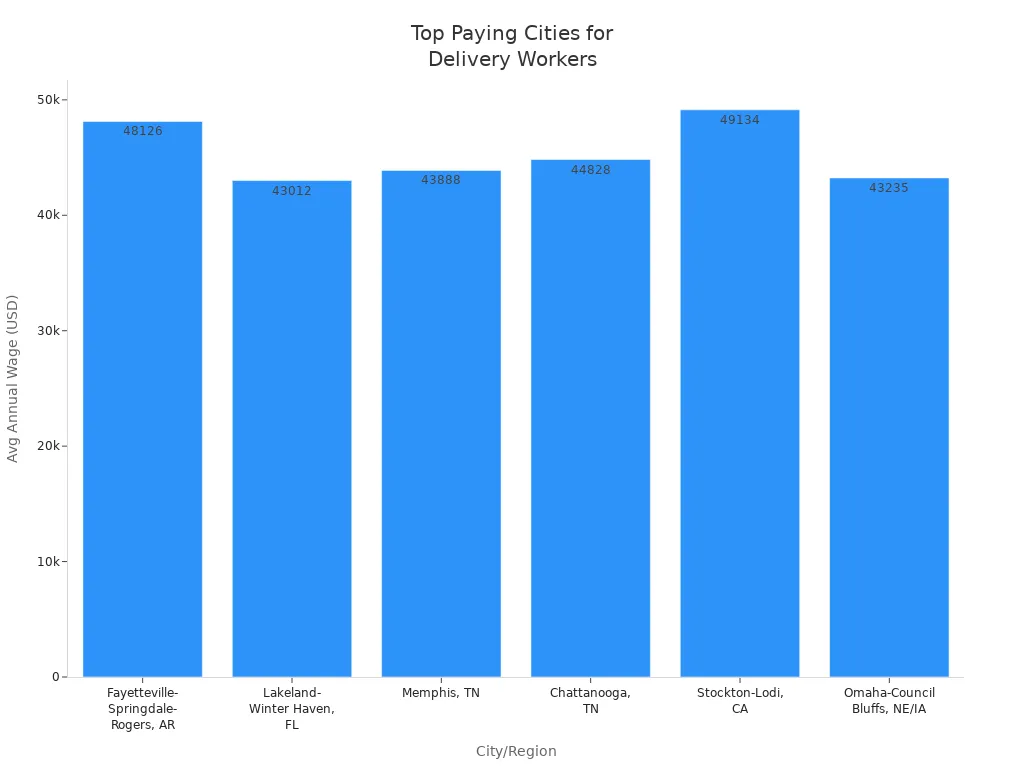Truck Drivers, Couriers, and Food Delivery Workers: Who Earns the Most?

If you want to know who earns the most, you should look at Truck Drivers. The latest numbers show light truck drivers make about $44,140 a year. Driver/sales workers earn around $37,130. Your pay can change a lot, though. Where you live and how much experience you have matter. Check out the differences in pay across regions and experience levels:

You might earn more in places like San Francisco or Anchorage. Your job choice, skill level, and location all play a big part in your paycheck.
Key Takeaways
Truck drivers generally earn the most, especially owner-operators and long-haul drivers, with potential earnings reaching over $250,000 a year.
Couriers earn a steady income, averaging around $54,760 annually, with opportunities for bonuses based on performance.
Food delivery workers can earn between $10 to $25 per hour, but tips significantly boost their income, especially during busy times.
Location and demand greatly affect pay; urban areas usually offer higher wages due to increased delivery needs.
Flexibility in work hours is a major benefit for couriers and food delivery drivers, allowing them to balance work with personal life.
Earnings Overview

Truck Drivers Pay
When you look at paychecks, Truck Drivers often come out on top. You can find many types of driving jobs, and each one pays a bit differently. If you drive long distances or own your own truck, you might see much higher earnings. Here’s a quick look at what you could make:
Earning Tier | Annual Pay | Monthly | Weekly | Hourly (Est.) |
|---|---|---|---|---|
Top Earners | $20,833 | $4,807 | $120 | |
75th Percentile | $222,000 | $18,500 | $4,269 | $107 |
Average | $121,175 | $10,097 | $2,330 | $58 |
25th Percentile | $60,000 | $5,000 | $1,153 | $29 |

You might wonder why some Truck Drivers earn so much more. Owner-operators, who run their own trucks and pick their routes, can make between $190,000 and $541,000 a year. Team drivers, who share the road with a partner, also see higher pay, around $119,464. If you haul special cargo, you could earn from $82,262 to $152,000. Where you drive matters, too. Big cities and busy routes usually pay more.
Tip: Owner-operators keep more of what they earn, but they also pay for fuel, repairs, and insurance. That means their take-home pay can be much lower than it looks at first.
Courier Earnings
Couriers deliver packages, documents, or medical supplies. You might work for a big company or a local business. The pay is steady, and you usually stay close to home. Here’s how courier pay stacks up:
Job Type | Median Hourly Wage | Annual Mean Wage |
|---|---|---|
Couriers | $22.10 |
Most couriers earn about $54,760 a year, which is higher than many food delivery jobs. If you work as a medical courier or handle urgent deliveries, you might earn even more. Private couriers sometimes get bonuses for fast or careful service.
Food Delivery Pay
Food delivery jobs are everywhere now. You can work for apps like DoorDash, Uber Eats, Grubhub, or Instacart. Your pay depends on how many orders you take, the tips you get, and if you work during busy times. Here’s what you might earn:
Platform | Average Pay (per hour) | Promotions |
|---|---|---|
DoorDash | Peak Pay bonuses, Challenges | |
Uber Eats | $15 - $20 | Quest Bonuses |
Grubhub | $12 - $18 | Blocks for scheduled shifts |
Postmates | $10 - $20 | Guaranteed earnings for a set number of orders |
Instacart | $15 - $25 | Limited promotions, larger tips for bulk orders |

Tips can make a big difference. Without tips, delivery drivers might only make $5 an hour. With tips, that number jumps to about $11.43 an hour. If you work during lunch or dinner rush, you can earn more with bonuses and peak pay.
Note: Food delivery jobs offer flexibility, but the pay can change a lot from week to week.
Who Earns the Most?
If you want the highest paycheck, Truck Drivers usually win. Owner-operators and long-haul drivers can earn six figures, especially if they work hard and manage their costs. Couriers come next, with steady pay and less risk. Food delivery workers earn less on average, but tips and bonuses can help boost your income if you hustle during busy times.
Factors Affecting Pay
Pay Structure
You might notice that pay works differently for each job. Some companies pay you by the hour. Others pay you for every mile you drive or every delivery you complete. If you work as a Truck Driver, you could earn a percentage of the load’s value or get a fixed salary. Team drivers split pay when they share long trips. Here’s a quick look at common payment methods:
Payment Method | Description |
|---|---|
Hourly pay | Drivers are paid a fixed hourly wage. |
Per mile pay | Compensation based on the number of miles driven. |
Percentage of load | Drivers earn a percentage of the load's value. |
Fixed salary | A set annual salary regardless of miles driven. |
Team driver pay | Compensation for driving as part of a team. |
Food delivery workers usually get paid per delivery. Couriers often earn hourly wages, but some get bonuses for fast or careful service.
Location Impact
Where you work can change your paycheck. Cities with lots of deliveries and high living costs usually pay more. For example, Stockton-Lodi, CA offers an average annual wage of $49,134 for delivery drivers. Fayetteville-Springdale-Rogers, AR pays $48,126. Omaha-Council Bluffs, NE/IA pays $43,235. You can see how pay changes across regions in this chart:

If you live in a busy city, you might find more jobs and higher pay. Rural areas often pay less because demand is lower.
Demand and Hours
Demand for delivery services goes up during busy times. You can earn more if you work during lunch, dinner, or holiday rushes. Flexible hours let you pick when you work. Part-time drivers often make extra money by working peak hours. The type of delivery service also matters. Some companies pay more for urgent or bulk deliveries. If you manage your routes well, you can handle more orders and boost your earnings. The rise of e-commerce means more jobs and better pay for drivers.
Higher demand during peak hours increases earnings.
Flexibility in working hours allows part-time drivers to earn more.
Urban locations generally provide higher pay due to demand and living costs.
Efficient management of delivery routes can lead to higher earnings without extending working hours.
Economic trends, such as the rise of e-commerce, are likely to boost demand for delivery services.
Tips and Bonuses
Tips and bonuses can make a big difference in your income. Food delivery workers often get tips from customers. These tips can make up 40–50% of your total earnings. Couriers and Truck Drivers may earn bonuses for safety, performance, or referrals. Some companies offer sign-on bonuses, retention bonuses, or even health club subsidies. Here’s a look at common bonuses:
Type of Bonus/Incentive | Description |
|---|---|
Safety Bonus | Rewards drivers for maintaining safe driving records. |
Sign-On Bonus | A one-time payment for joining the company, often with conditions. |
Performance Bonus | Based on metrics like safety, fuel efficiency, or customer feedback. |
Retention Bonus | Incentives for staying with the company over a period of time. |
Referral Bonus | Rewards for referring new drivers to the company. |
Tenure Bonus | Recognizes long-term loyalty to the company. |
Education Reimbursement | Supports drivers in earning or maintaining credentials. |
Health Club Subsidies | Helps drivers maintain health while on the road. |
Guaranteed Pay Programs | Ensures income stability during training or slow periods. |
💡 Tips and bonuses can boost your pay, especially if you work hard and take advantage of busy times.
Pros and Cons
Income Stability
When you look for steady income, truck driving stands out. You see stable or even rising employment for drivers over the years. Truck drivers often enjoy increasing pay because companies need more drivers. The trucking job market stays strong, even when other industries slow down.
But you should know that income can change. The trucking industry faces higher costs, like fuel prices and maintenance. Companies sometimes struggle with tight profit margins. Labor shortages also make things unpredictable. If you work as a courier or food delivery driver, your earnings might swing up and down based on demand, competition, or even the weather.
Driver jobs stay stable or grow slowly, showing a strong labor market.
Truck driver pay rises as demand increases.
Economic pressures, fuel price changes, and labor shortages can affect your earnings.
If you want a job with steady pay, trucking usually offers more stability than food delivery or courier work.
Flexibility
You might love the freedom these jobs offer. Many drivers say flexible schedules are a big perk. You can choose your hours, pick up extra shifts, or work part-time. Food delivery and courier jobs let you work when you want, which helps if you need to fit work around school or family.
Still, flexibility comes with trade-offs. You often feel pressure to meet delivery deadlines. Sometimes, you skip breaks or rest to finish your route. Flexible hours can mean less rest, especially during busy times.
Flexible schedules attract many drivers.
You may lose rest time if you rush to meet deadlines.
Want to set your own hours? Delivery jobs give you that option, but you need to manage your time well.
Job Demands
Driving for work can be tough. You spend long hours behind the wheel, which leads to back pain and tiredness. Busy streets and tricky customers add stress. You might feel lonely, especially if you work alone. The push to deliver quickly can cause accidents or burnout.
You also deal with extra costs, like fuel and repairs. Most drivers handle their own health insurance, which adds stress. Your income can change with demand, competition, or bad weather.
Long hours and little support can lead to high turnover.
Lack of good equipment may cause safety issues.
Competitive pay and chances to move up help drivers stay longer.
Feeling valued and safe at work boosts job satisfaction.
Impact on Retention Rates | |
|---|---|
Long hours | Leads to dissatisfaction and increased turnover. |
Inadequate support | Raises stress and job dissatisfaction. |
Lack of proper equipment | Causes safety issues and affects job security. |
Competitive pay | Attracts and keeps drivers. |
Career advancement opportunities | Improves satisfaction and retention. |
If you want to stick with a driving job, look for companies that care about your safety and offer chances to grow.
Choosing Your Path

Matching Goals
You want a job that fits your life, not just your wallet. Before you choose, think about what matters most to you. Some people care about family time. Others want fast cash or flexible hours. Here are a few things to consider:
Truck driving means long hours on the road. You might spend days or weeks away from home. If you value family dinners or want to be home every night, this could be tough.
Health matters. Truck Drivers often face health problems like obesity and heart disease. Sitting for hours and eating on the go can hurt your well-being.
Courier and food delivery jobs offer more flexibility. You can work part-time or pick your own schedule. If you want to balance work with school or family, these jobs might suit you better.
Quick earnings can help if you need money now. Food delivery and courier work pay out faster, especially with tips.
Tip: Write down your top priorities. Do you want steady income, flexible hours, or time with family? Your answer will guide your choice.
Long-Term Outlook
You should also think about your future. Jobs in delivery and trucking keep growing as online shopping gets bigger. Here’s what the numbers say:
Occupation | Projected Growth (2016-2026) | Notes |
|---|---|---|
Delivery Truck Drivers | 4% | Slower than average for all occupations. |
Light Truck/Delivery Services Drivers | 7% | Growth driven by e-commerce demand for package delivery services. |
Driver/Sales Workers | Little or no change | Self-employed contractors may be needed for food delivery from restaurants. |
Companies like FedEx and UPS keep hiring new drivers. They offer good pay and benefits.
The trucking industry faces a shortage of drivers. More jobs open up every year. Some companies pay up to $110,000 for new hires.
Automation is coming, but demand for drivers stays strong. E-commerce means more packages and more work.
If you want a job with room to grow, Truck Drivers and couriers have solid prospects.
Note: Think about where you want to be in five years. Delivery jobs can be a stepping stone or a long-term career.
Truck driving usually brings in the highest pay, especially if you own your truck or drive long distances. Still, money is not the only thing that matters. You should think about safety, job security, and how much freedom you want. Here are some things to keep in mind:
Factor | Description |
|---|---|
Safety | Staying safe on the road keeps you healthy and working. |
Customer Service | Being friendly can lead to better tips and happier days. |
Time Management | Good planning helps you finish jobs on time. |
Flexibility | Picking your own hours can make life easier. |
Independence | You get to work on your own and make your own choices. |
Job Security | A steady job helps you plan for the future. |
Think about what matters most to you. The best job is the one that fits your life and goals.
FAQ
How much can you really make as a food delivery driver?
You can earn $15–$25 per hour with tips during busy times. If you work in a busy city and pick up lots of orders, your pay goes up. Slow days or small towns mean less money.
Do truck drivers get paid for overtime?
Most truck drivers do not get overtime pay. You usually get paid by the mile or by the load. Some companies offer bonuses for extra hours, but overtime rules do not always apply.
Is courier work safer than truck driving?
Courier jobs usually keep you closer to home and off highways. You face less risk from long drives or bad weather. Still, you need to watch out for traffic and heavy lifting.
Can you switch from food delivery to truck driving?
Yes! Many people start with food delivery and move to bigger vehicles. You need a commercial driver’s license (CDL) for most truck driving jobs. Training programs can help you get started.
See Also
Unlocking Logistics Savings: Expert Tips For Streamlined Operations
Exploring AI's Hidden Benefits In The Logistics Sector
Understanding Current Trends In Logistics Risk Management
Five Leading Logistics Solutions To Watch In 2024
Essential Strategies For Reducing Logistics Costs Effectively
